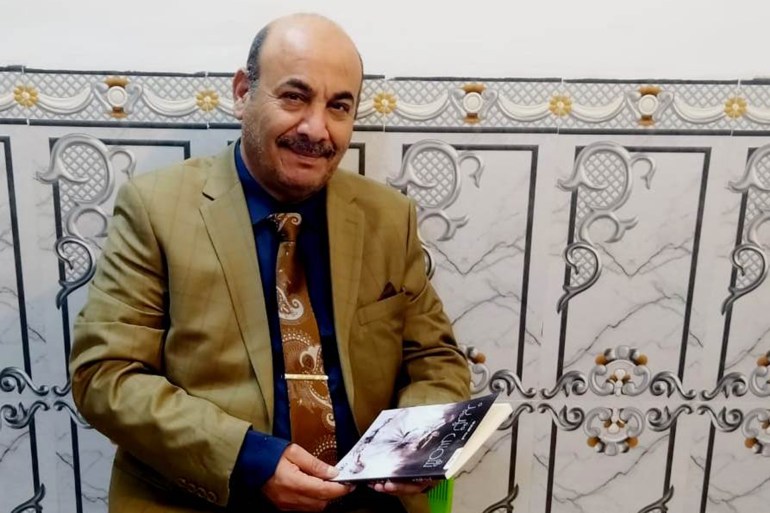Karbala -
The novel "Shams of Tabriz" by the Iraqi critic and writer Ahmed Al-Shatri discusses the subject of Sufism through the character of Shams Al-Din Al-Tabrizi, who represents the centerpiece of the novel, which seeks the truth through a series of relationships and mystical aspirations that enter as an integral part of the main idea.
Al-Shatri tends to spread the focus of the conflict through the hero's attachment to Shams al-Din al-Tabrizi when he goes to the city of Tabriz in search of the secrets of this mystical pole, but he suffers an accident that causes him to lose his memory, and leads him to form new social and cognitive relationships.
After his memory returns to him, he returns to his country to discover the loss of 7 years of his life he does not know anything about, and through written notes he finds the relationships he formed in that period, to start a new struggle in search of his son who gave birth to him in that period and is linked by name with The character of Shams Al-Din Tabrizi
Al-Shatti tends to broadcast the focus of the conflict in the novel through the hero's attachment to Shams Al-Din Al-Tabrizi (Al-Jazeera)
clash of places
Ahmed Al-Shatri, born in Dhi Qar Governorate (southern Iraq) in 1961, says about his first novel (Shams of Tabriz) that “the novel in its idea is in response to the repeated invitation of a visitor in a dream who comes to him in the form of Shams al-Din al-Tabrizi, so he goes to Iranian Tabriz to discover the secret and purpose of this invitation.” .
But this access is not achieved, as “the bus accident leads to his loss of memory, so he lives for 7 years in Tabriz, moving between the spiritual atmosphere in which he is immersed and the family atmosphere that he prepares for his marriage to a woman named Shireen, so he experiences another shock by losing her during childbirth, and turns wandering in the Cities meet with groups of Sufis.
The novelist indicates that the hero passes through the city of “Qom” from which he made his first starting point towards Tabriz, and, as Al-Shatri says, “has a collision with a bicycle and is taken to the hospital to regain his memory, and return to his homeland,” but the idea does not stop here, and says that “his confusion and research About the seven years lost of his life, they prompt him to read the diary he brought with his belongings, the dates of which correspond to the stage of his amnesia, so he returns to search for the truth of his connection to those notes.
He goes on to say that by research he discovers "the possibility that he will have a son from that woman he married", which forced the hero to "travel again to the wife's parents to find a child with them whose age is close to the age of his supposed son", and the conflict is once again in revolutionizing the idea. Its purpose is, so al-Shatti makes “the wife’s family deny his relationship with him and claim that he is the son of their son.”
However, he discovers in those notes that “his wife told him that her brother is sterile, to remain attached to that boy without being able to prove his sonship to him,” so the hero’s author pushes the hero to go to the city of Tabriz again, “to search for the secrets of the mystical pole Shams al-Din al-Tabrizi.” This enabled him to "form new social and cognitive relationships".
self discovery
Critic Khalil Muzhir Al-Ghalbi says that "Al-Shatti's experience in his novel depends on a number of assumptions, both of which are general Sufi visions in the structures of the narrative or its dialogic generators, and in its open-minded relative mystic meaning on the other hand."
He believes that the writer worked on this idea "to prepare it to be appropriate and capable of its intellectual visions influenced by the visions of the two Sufi symbols Jalal al-Din al-Rumi and his teacher Shams al-Tabrizi in the field of elevating the human spirit."
He believes that the intellectual mixing in the stages of the hero's movement, which he called "Muhammad", in those relationships that he wants to dismantle, tended "to reveal his visions related to his private biography and influenced by the two Sufi symbols, so the protagonist's statements carried many of his visions and philosophy derived and influenced by his tendency to gnosticism that avoids the love of women." With a disciplined natural impulse far from moral slander,” which made the novel take “the mystical approach to mature attempts in which the narrative and mystical discourses fuse,” and the aim was to “remove the narration from confusion and some mistrust with which it shocks the recipient with strange and out of the ordinary tendencies of Sufism through sign language. and far-spirited revelation.”
Passion for Sufism
However, critic Wejdan Abdel Aziz believes that the novel has “a mixture of subjectivity and objectivity that resulted in a scene narrative that stumbled at times and rose at other times,” considering it an autobiographical novel, “the success of which depended on the writer’s ability to manage events and make them far from direct realism.”
He believes that al-Shatri "showed a passion in following the path of Sufism and trying to absorb their knowledge of Illumination, especially Shams al-Din al-Tabrizi. The document or the notes that link the events can be considered “a technique based on recall and rumination of events, and it was able to bring the mystic closer to awareness and reality, and the loss of memory in a narrative mixture.”

